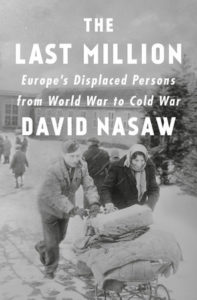
Finding a Home for the Last Refugees of World War II
David Nasaw on the People with Nowhere Left to Go
Despite the logistical problems—the lack of rolling stock, trucks, and cargo planes, the bombed-out roads and bridges, shortages of food and fuel, and the exhaustion of the troops who, having fought and won the Second World War, now had to transport millions of civilians home—the repatriation campaign succeeded beyond expectations.
By October 1, 1945, more than 2 million Soviets, 1.5 million Frenchmen, 586,000 Italians, 274,000 Dutch citizens, almost 300,000 Belgians and Luxembourgians, more than 200,000 Yugoslavs, 135,000 Czechs, 94,000 Poles, and tens of thousands of other European displaced persons, or DPs, had been sent home.
There remained left behind in Germany more than a million displaced persons warehoused in camps, overseen by the occupying militaries and the United Nations Relief and Rehabilitation Authority (UNRRA), which had been organized in 1943 to oversee wartime recovery and the repatriation of the displaced.
The Last Million is the story of these displaced Eastern Europeans who, when the shooting stopped, refused to go home or had no homes to return to. It is the story of their confinement in refugee camps for up to five years after the war ended.
The Polish Catholics who comprised the largest group of displaced persons had come to Germany during the war, the vast majority deported against their will as forced laborers to replace soldiers sent to the eastern front. They had homes and families to go back to and a government that welcomed their return, but hundreds of thousands preferred to remain in refugee camps in Germany. Caught up in the postwar conflict between East and West, they had been warned—and heeded those warnings—not to return to a Poland devastated by war, threatened by civil war, no longer independent but under Soviet domination, its eastern provinces ripped away and annexed by the USSR.
The Estonians, Latvians, Lithuanians, and some of the western Ukrainians had, unlike the Poles, departed their homelands voluntarily in the final year of the war, in flight from the advancing Red Army. Large numbers of them had collaborated with the Nazi occupiers; some had participated in the slaughter of their Jewish neighbors; a significant number had fought in German uniforms as part of Waffen-SS units. Even the innocent among them whose collaboration had entailed nothing more than working in a post office under German superiors feared that should they return they would be charged with treason or war crimes. They preferred to remain in the relative safety of the displaced persons camps in Germany until their nations were liberated from the Soviets or they could start their lives anew somewhere else.
A much smaller number of Jewish survivors of concentration, labor, and death camps had entered Germany in the last months of the war. As the Red Army moved westward, German officials, fearful lest the world discover the full extent of Nazi atrocities, had loaded them into boxcars or death-marched them into Germany to work them to death in the underground munitions factories that Hitler believed were going to produce the miracle weapons that would win the war for the Third Reich. Those still alive when the war ended had no families, no homes, no loved ones to return to. Their ultimate destination, they hoped, would be a Jewish homeland in Palestine or with family members in the United States, but for now they had no choice but to remain in the displaced persons camps in Germany, where they were fed, sheltered, and protected by the American and British militaries, and where they enjoyed a measure of security they had not known since the war began. They were a small minority of the Last Million, numbering under 30,000, until in 1946 they would be joined in the displaced persons camps in Germany by the Polish Jews who had escaped death by fleeing across the border into the Soviet Union.
The United States was among the last nations to welcome the Last Million for resettlement.
The camps in which the Last Million would spend the next three to five years were conceived as temporary facilities, but converted by the displaced persons into island communities, divided by nationality, with their own police forces, administrative committees, churches, schools, theaters, newspapers, and medical services. Food, supplies, and security were provided by the military; special assistance and support by accredited religious and ethnic voluntary organizations; administrative oversight by UNRRA. Black market operations connected insiders with German civilians outside and brought into the camps luxuries and necessities not otherwise available.
The Last Million were able to exert some control over their daily lives in the camps, but not over their futures. Those who were willing to return home would be assisted in doing so. But those who had no intention of going home again or had no homes to return to were marooned, with neither the resources nor permission nor the documents they needed to leave the camps and Germany and resettle elsewhere.
Their fate was in the hands of the Allies, who remained sharply divided over what to do with them. The Americans and the British were agreed that the Eastern Europeans whose lands had been occupied or annexed by the Soviets had the right to refuse or delay repatriation, if that was what they chose, and the international community had the responsibility of caring for them until they decided to go home again or a place was found for them to resettle.
The Soviets and the Eastern bloc of nations where the DPs had formerly lived demanded that they be repatriated. Only the Jews and Spanish Republicans were, they argued, truly displaced; the others had homes to return to and nations ready to welcome them. Those who sought refuge in the camps were, they insisted, refusing repatriation because they preferred being fed by the western Allies and UNRRA to working to rebuild their shattered nations, or, worse yet, because they feared punishment as quislings, Nazi collaborators, or war criminals should they return home. Fearful that the Americans and the British, their former allies, were under the protective cover of UNRRA warehousing anti-Communist, anti-Soviet dissidents to later deploy in counterrevolutionary propaganda or military campaigns not dissimilar to the ones they had launched after the Russian Revolution, the Soviet bloc nations demanded that the camps be closed and the displaced persons sent home or left to fend for themselves without Allied or UNRRA assistance.
After a year of fruitless and increasingly acrimonious debate and the obstinate refusal of the Last Million to go home, the Americans and the British concluded that, repatriation having failed, they would have to resettle the displaced persons in new homes and homelands outside Germany. UNRRA would be replaced by the International Refugee Organization (IRO), whose mandate would be resettlement, not repatriation. The Soviet bloc nations tried, without success, to block the establishment of the new organization, then refused to join or contribute to its financial support.
With no legal route out of the camps, thousands left clandestinely for ports from which they could sail to and enter Palestine.
The IRO would succeed in removing the Last Million from the camps by marketing them as the solution to labor shortages aggravated by the recent war. Britain, France, Belgium, and then Canada, Australia, and the nations of South America and the Caribbean were encouraged to send recruiting teams to the camps to select displaced persons to fill their particular labor needs. The first choices of the recruiters were the Latvians and Estonians because they were white, Protestant, healthier than the forced laborers and concentration camp survivors, reliably anti-Communist, and with a reputation for being disciplined and diligent. Next were the Lithuanians, Ukrainians, and Polish DPs. Ignored or intentionally discounted in the recruiting nations’ eagerness to gain a cheap labor force was the fact that a not insignificant proportion of the Baltic and some of the Ukrainian DPs had collaborated with the Nazi occupiers or fought alongside them.
The IRO member nations that accepted for resettlement hundreds of thousands of Protestant, Catholic, and Eastern Orthodox Eastern Europeans refused to do the same for the 200,000 to 250,000 Jewish displaced persons, who remained trapped in the camps in Germany, the land of their murderers, awaiting the opening by the British of the gates to Palestine or the offer of visas to the United States, Canada, or Australia. With no legal route out of the camps, thousands left clandestinely for ports from which they could sail to and enter Palestine. From the moment he assumed office in April 1945, President Truman had believed that in order to remove the Last Million from Germany, he would have to pressure the British to open Palestine to Jewish immigration. Only when it became clear that the British were not going to do so did he recommend that Congress consider passing emergency legislation to admit America’s “fair share” of Europe’s refugees, including significant numbers of Jewish survivors.
The United States was among the last nations to welcome the Last Million for resettlement, save those whom the CIA and State Department deemed useful for clandestine Cold War campaigns at home and abroad. Though the White House; the State Department; Jewish, Catholic, and Protestant churches and voluntary organizations; distinguished citizens; and prominent politicians from both sides of the aisle supported legislation that would permit some of the displaced persons to enter the country, the pushback from midwestern Republicans and southern Democrats stalled, then transfigured the displaced persons bill introduced in Congress into something quite different from what Truman and its proponents had envisioned. The major obstacle, though never articulated as such, was the admission of the Jewish DPs, some 150,000 to 200,000 of whom had entered the camps from Poland in 1946 after surviving the war in the USSR. The opponents of DP legislation, trading in timeworn Judeo-Bolshevik conspiracy theories, suggested that those who had lived in the Soviet Union or Soviet-dominated Poland and been liberated by the Red Army were more than likely to be Communist sympathizers or clandestine operatives and, for that reason alone, should be barred from entering the United States.
Congress procrastinated, investigated, debated endlessly, as Cold War fears supplanted memories of Second World War atrocities. The displaced persons bill that was finally passed in June 1948, three years after the German surrender, was blatantly, frighteningly discriminatory. It granted visas only to those who were reliably anti-Communist and excluded the Polish Jews who were not. Forty percent of the visas were reserved for displaced persons whose homelands had been annexed by a foreign power—that is, Estonians, Latvians, Lithuanians, and western Ukrainians, those DP populations with the largest number of collaborators, war criminals, and quislings among them. Ninety percent of the Jewish DPs from Poland who had entered Germany after December 22, 1945, were declared ineligible for admission under the legislation.
With Congress opposing the entrance of large numbers of Jewish DPs to the United States and no other nation willing to accept them, the president had only one option available to him: to relocate them to Palestine. The alternative was to compel the Jewish survivors to remain on German soil, under German law and police powers, in the nation whose leaders had attempted and nearly succeeded in exterminating them. Overriding State Department concerns, President Truman supported the UN resolution for the partition of Palestine and then recognized the independence of Israel.
With the vast majority of the Jewish displaced persons on their way to an independent Israel and the United States having opened its doors, the Last Million were, some of them after five years in the camps, removed from Germany and scattered throughout the nations of the earth. That among them were thousands who had collaborated with the Nazi occupation forces, served in German-organized and-commanded Waffen-SS units, and/or committed war crimes would not be publicly revealed for another three decades.
__________________________________

From The Last Million by David Nasaw. Reprinted by arrangement with Penguin Press, a member of Penguin Group (USA) LLC, A Penguin Random House Company. Copyright © David Nasaw, 2020.
David Nasaw
David Nasaw is the author of The Patriarch, selected by the New York Times as one of the 10 Best Books of the Year and a 2013 Pulitzer Prize Finalist in Biography; Andrew Carnegie, a New York Times Notable Book of the Year, the recipient of the New-York Historical Society’s American History Book Prize, and a 2007 Pulitzer Prize Finalist in Biography; and The Chief, which was awarded the Bancroft Prize for History and the J. Anthony Lukas Book Prize for Nonfiction. He is a past president of the Society of American Historians, and until 2019 he served as the Arthur M. Schlesinger, Jr. Professor of History at the CUNY Graduate Center.



















